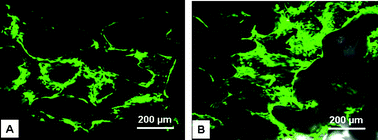Synthesis, degradation and biocompatibility of tyrosine-derived polycarbonate scaffolds
Abstract

- This article is part of the themed collection: Tissue Engineering
* Corresponding authors
a
Department of Chemistry and Chemical Biology and New Jersey Center for Biomaterials, Rutgers, The State University of New Jersey, 145 Bevier Road, Piscataway, NJ, USA
E-mail:
kohn@rutgers.edu
Fax: +1 (732) 445-5006
Tel: +1 (732) 445-0488
b Bone Tissue Engineering Center, Department of Biomedical Engineering, Carnegie Mellon University, Pittsburgh, PA, USA

 Please wait while we load your content...
Something went wrong. Try again?
Please wait while we load your content...
Something went wrong. Try again?
M. H. R. Magno, J. Kim, A. Srinivasan, S. McBride, D. Bolikal, A. Darr, J. O. Hollinger and J. Kohn, J. Mater. Chem., 2010, 20, 8885 DOI: 10.1039/C0JM00868K
To request permission to reproduce material from this article, please go to the Copyright Clearance Center request page.
If you are an author contributing to an RSC publication, you do not need to request permission provided correct acknowledgement is given.
If you are the author of this article, you do not need to request permission to reproduce figures and diagrams provided correct acknowledgement is given. If you want to reproduce the whole article in a third-party publication (excluding your thesis/dissertation for which permission is not required) please go to the Copyright Clearance Center request page.
Read more about how to correctly acknowledge RSC content.
 Fetching data from CrossRef.
Fetching data from CrossRef.
This may take some time to load.
Loading related content
